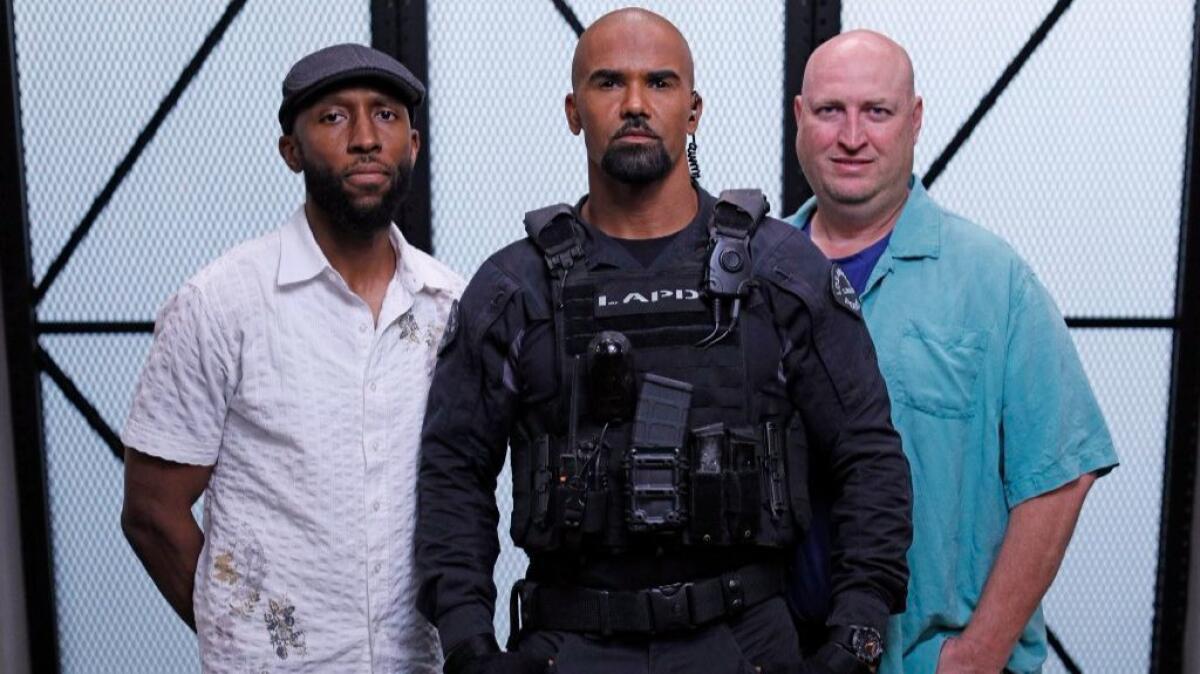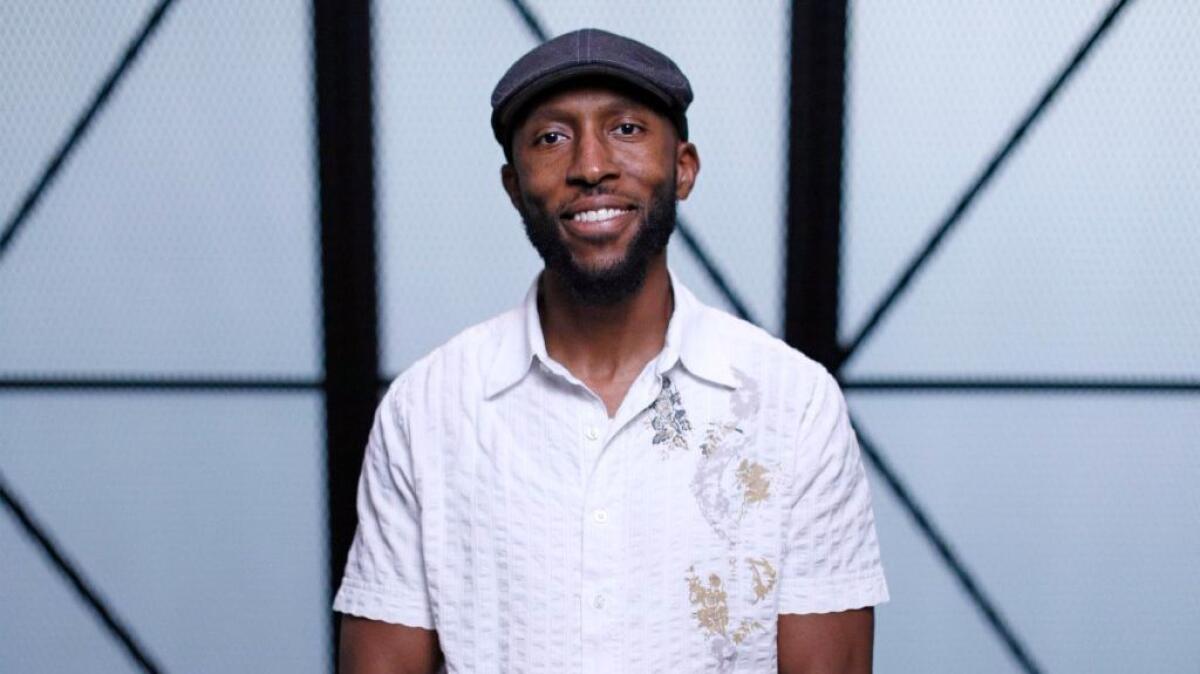For Aaron Thomas the ‘S.W.A.T.’ reboot offers opportunity for diverse representation

- Share via
On a Santa Clarita soundstage, a team leader thanks his crew for all their hard work during a scene for the new iteration of “S.W.A.T.,” which premieres Thursday on CBS. Like the speech, the part of the set known as “the eagles nest” — a sleek concrete and steel space that includes a boxing ring, a cafeteria and a command center with flat screen TVs -- is somewhat standard issue.
The team leader, however, is not.
Daniel “Hondo” Harrelson, played by Shemar Moore (“Criminal Minds”), intentionally straddles two worlds — a kid from South Los Angeles who now runs the local special weapons and tactics team.
It is not a tableau that “S.W.A.T.” executive producer Aaron Rahsaan Thomas remembers ever seeing in his TV-junkie youth. As a kid in Kansas City, Kansas, Thomas consumed everything from Norman Lear comedies to “Hill Street Blues” and as he grew up, he began to notice something.
Or, more precisely, the absence of something.
“There weren’t enough dramas that were taking people of color seriously,” he says.
Yes, there were iconic characters like Huggy Bear on “Starsky and Hutch,” or B.A. Baracus on “The A-Team,” but their main function was to provide comic relief, just as black guest stars were brought in to function as either short-lived saviors or sinners. As a budding writer, Thomas pondered the meaning of representation and wondered why a black character couldn’t be “intelligent, serious, and focused.”
So, after working on shows as varied as “Soul Food,” “Friday Night Lights” and “The Get Down,” the USC film school grad decided to write the character he so rarely saw.
His script came to the attention of Sony, which was looking to reboot “S.W.A.T.” along the lines of the 2003 film adaptation of the ’70s TV show.
The new series retains the original’s funky theme song — with fresh “stank,” according to Moore — but it features many modern updates including a female SWAT officer, played by Lina Esco, and a racially diverse cast.
Teamed with Shawn Ryan, creator of “The Shield,” Thomas and fellow executive producers Neal Moritz — who produced the 2003 film — and Justin Lin of “The Fast and the Furious” franchise wanted to go further than window dressing. They were pleasantly surprised that CBS — a network that has repeatedly been criticized for its lack of diversity — wanted to do the same.
“Definitely there was a healthy level of skepticism when it came to whether or not they wanted to do anything different creatively,” says Thomas, who previously worked on the CBS shows “Numbers” and “CSI: NY.” “To our fortunate surprise, from the very beginning they were really, really adamant about trying to stay within their brand but do the next wave, the modern version. To lean into some areas that they hadn’t touched on before.”
The pilot revolves around the accidental shooting of an unarmed black teen by a SWAT team leader and the political appointment of Hondo in the aftermath. (Hondo, the story makes clear, is capable: He’s just not the next in line.) Though packaged with high-speed car chases and predictable shoot-outs (directed in the pilot by Lin), the ensuing discussion of both black and blue lives is sharper than one might expect.
“CBS gets beaten up sometimes, but I’d like to give them some credit here,” says Ryan, sitting in an office close to the set. “When we were working on the early drafts, the feedback to us was: ‘This feels like something that you think CBS wants, rather than what you want.’ They really encouraged us to take some more chances and not be prisoners of a preconceived notion about what a quote-unquote CBS show was.”
From casting to story beats, Ryan says, “they supported everything we had in the script, all the political stuff you’re referencing, all the character stuff.”
That support is crucial to Thomas. Even within the limitations of a network police procedural in which the SWAT officers are, essentially, heroes, he has created characters and story lines that he hopes will spark debate on topical issues.
He was inspired, he says, by his own experience. When he was a child, Thomas lived near a young boy who was shot by police. But there was a cop living nearby as well, a man who taught neighborhood kids to ride their bikes and throw a spiral.
“If you could catch his ball then you knew you could catch,” says Thomas. “When that shooting went down, he completely understood why people would be outraged by it. He was Hondo. I always remembered the guy on our block who helped to teach us to play catch. I always thought about him and it kept me from having bitterness towards police in general.”
“If there’s one unifying thing about this show,” says Ryan, “it’s that you don’t just have to have cops on one side, Black Lives Matter people on the other, that there is a middle ground. And maybe it can be found via a guy like Hondo.”
Moore, the man who plays Hondo, goes even further. “I really think we’re about to raise the bar and change the network television game in the way stories are told.”
“S.W.A.T.” is also unapologetically a showcase for the diversity, geo- and demographic, of Los Angeles. Venturing far beyond the traditional palm trees versus mean streets depictions, the stories will make the most of L.A., moving from Boyle Heights to Filipinotown to Brentwood and beyond.
In that vein, it was important that “S.W.A.T.” employ a writing and directing staff that includes women and people of color. (In fact, two of the first people encountered on the set on this day of shooting are executive story editor Angela Allen and director Holly Dale.)
Which in turn reflects the evolution of the show’s subject matter.
“In the actual SWAT headquarters there are class photos,” says Thomas. “Rows of white faces until very recently when things became a little more diverse. There’s a meta message definitely to seeing a person of color promoted to a position of leadership on a show. Hopefully the show, in its own way, can be part of a conversation for a new generation.”

It’s a pretty ambitious goal, for a CBS procedural and a newbie creator. But Thomas seems confident in his vision, which is exactly why “Friday Night Lights” executive producer Jason Katims gave the young writer his biggest professional break on that show more than 10 years ago.
“[I] loved his voice in the room,” says Katims via email. “He was a very new writer then… but he had a quiet confidence about him and always came at story from a place of being authentic and honest.”
“He has such a great energy,” says Jay Harrington of Thomas, taking a break from a scene decked out in full SWAT regalia. The veteran actor, best known for comedies (including the late, lamented “Better Off Ted”) plays Deacon, the man Hondo leapfrogs over to become team leader. Harrington was drawn to Thomas’ desire to tweak the cop show formula. The shows will be able to stand alone, he says, but “they assembled an amazing writing staff who enjoy intensive character study.”
Characters matter, says Thomas.
“This is not just an idea that I just want to get on the air, I actually believe in the message,” he says, taking a seat in the cafeteria set as the actors depart to shoot on another stage. “For me what it represents, ultimately, is hope of better communicating between individuals and bodies of people, overall. The couple watching this in Nebraska, even if they never met Shemar before, they can start to connect in a way that maybe they haven’t before. This may be the only time where they meet such a diverse range of people and what are you going to say? What are you going to do with that platform now that you have 43 minutes of their time? I genuinely believe that it can help in its own way.”
ALSO:
Review: ‘Stranger Things’ returns with new tales of terror from the Upside Down
Jay Pharoah jumps from ‘Saturday Night Live’ to the fame game of ‘White Famous’
Q&A: In the Netflix docu-series ‘The Day I Met El Chapo,’ Kate del Castillo tells her story
More to Read
The complete guide to home viewing
Get Screen Gab for everything about the TV shows and streaming movies everyone’s talking about.
You may occasionally receive promotional content from the Los Angeles Times.







